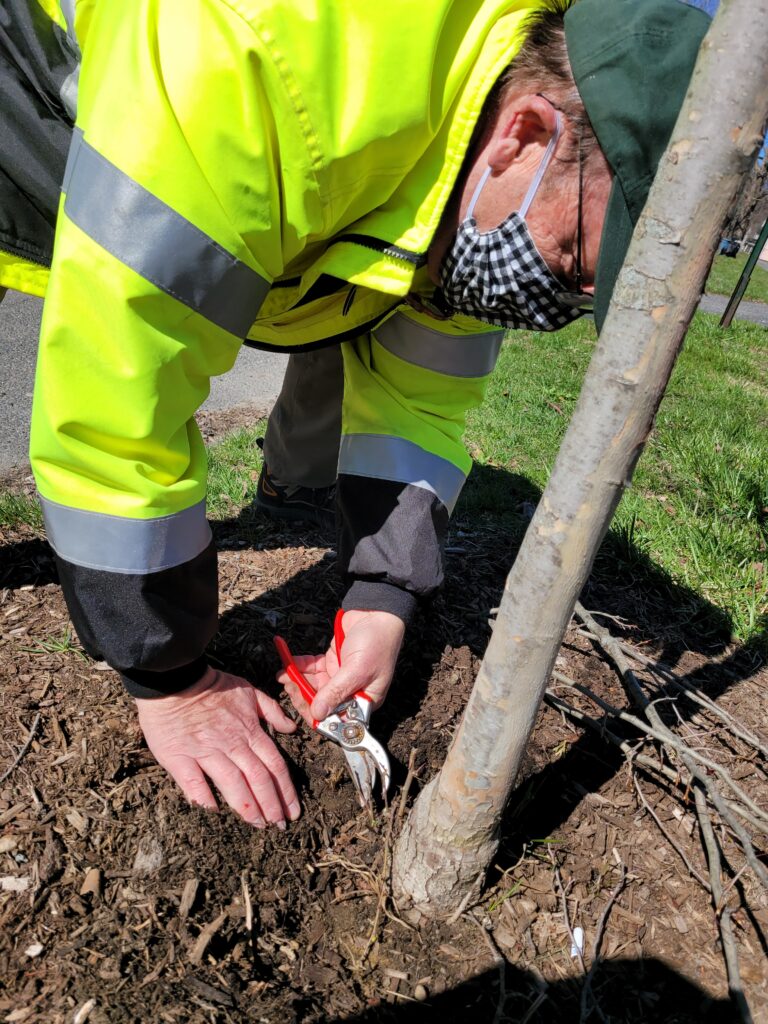An Interview with Jay Girard, Certified Arborist for the Pittsfield GGCP
The Greening the Gateway Cities Program (GGCP) could not exist without the dedication and knowledge of the foresters from the Massachusetts Department of Conservation & Recreation (DCR) Urban & Community Forestry Program.
Jay Girard is the Certified Arborist and MA DCR urban forester for the Pittsfield GGCP, who has led the tree planting efforts in Pittsfield since 2018. Girard has been a Certified Arborist for over 25 years, and he has worked in the tree care industry for over 45. Urban foresters work within the city landscape, and their goal is “to site what they call the right tree in the right place”. “We’re trying to get a higher canopy for the city, for more shade, (and to) keep heating and cooling costs down”, says Girard. “And we’re also trying to fit the right tree into the right site whether it’s shade or sun, whether you’re trying to get a wind block, or if you’re planting under the wires. We have about 40-50 trees that we work with and we have something to fit every niche. My job is to pick out the correct tree and work with the homeowner to get something they like that will fit into their land.”
2892 trees have been planted to date in the city of Pittsfield since 2016 as part of the Greening the Gateway Cities Program, with the goal being to reach 3000 trees planted. “We have 60-70 trees sited already in Pittsfield so we will meet that goal quite nicely,” says Girard. “There are still opportunities to get a tree but act quickly. Go to www.maurbancanopy.org and if in the planting area, call and the urban foresters will schedule a site visit.”
“One of my goals, and the goals of the program especially, is to get a diversity of tree plantings so we don’t end up with the same situation that we’ve had with the Asian Longhorned Beetle and the Emerald Ash Borer (two insects) wiping out a whole species (of tree) and taking out a good percentage of the city. We are trying to keep the percentages of each species pretty low, each genus pretty low, and we’ve done a pretty good job of that throughout the state.”
Planting your tree correctly and next steps
To plant your tree correctly, you need to find the root flare which is where the roots transition into the stem. When planted, the root flare needs to be at ground level. If you plant the root flare too deep, you can significantly shorten the lifespan of the tree. Next you will need to create a mulch ring around the newly planted tree about 2.5 to 3 feet in diameter and not very deep. You do not want to create mulch “volcanos” around your tree as tree bark is not meant to be wet constantly and wet mulch touching the bark can cause the bark to rot and eventually kill the tree. Leave three inches of space between the start of the mulch and the tree stem. The mulch is intended to help retain water (root systems can be constantly wet) and keep away weeds. Lastly, the newly planted tree should be staked into the ground to ensure it settles into the ground straight. (The experienced urban foresters take care of the planting, staking, and initial mulching in the GGCP program.)
Once the tree is planted, it needs to be watered weekly for two years until the new root system is established. Girard recommends 15 gallons of water per week per tree, and if it gets very hot in the summer, doubling that amount. Give your tree 15 gallons of water all at once, and then maybe give it another 15 gallons at another time during the week. You can use a five-gallon bucket to measure out the proper amount, and to save yourself a backache, fill the bucket at the tree using a garden hose.
The stakes on the tree usually can come off after one growing season. “We’ve had issues where people have left the stakes and the wrap on too long and the tree tries to grow right through them or around them,” says Girard. “And you can strangle the tree that way or get the material caught into the bark system.”
Knowing your tree is important. “Once you get a tree, do a little research. Know what it is, how big it’s gonna get, and what kind of care it needs. There’s a lot of information on the internet. You can go on our website www.maurbancanopy.org and there are some references there that you can use. Learning about what you have and how it grows is probably the best advice I can give. And also rely on a Certified Arborist or someone who’s been trained in the industry to get advice from. Usually, your neighbor is not your best advice” (unless you neighbor happens to be Jay Girard).
“If you see the leaves (of your tree) start to wilt at all, that’s the time to get the water out, and really that’s the key, to water your tree for the first 2 years to get that root system established. You can overwater your tree, but if you go with the 15 to 30 gallons of water per week you should be good”, says Girard. “For city trees that we plant, we put out what they call gator bags or water bags around the tree that hold 20 gallons of water so we can just go fill that bag, we don’t have to worry about measuring it.”
If you catch wilting leaves early enough you can turn around the tree health quickly with diligent watering. “If you are having a root problem in the tree, the top of the tree is usually the first part of the tree that will start to die back, and if you see that problem, again probably water is what you need to do.”
When watering your tree, keep an eye out for any issues. Remove any mulch that is touching the tree, remove any broken branches, and check the bark carefully. If you see a little hole in the tree, gently pry back the bark and look to see if there is an insect in there. If you see an insect, insert a piece of wire into the hole to kill the borers so they don’t reproduce and either kill that tree or go on to attack other trees.
After your trees have been in the ground for two or three years, Girard recommends some corrective pruning. For the long-term health of the tree and its structural integrity (ability to withstand storms and winter conditions), you need to establish a good central stem structure to the tree. Girard recommends having someone who knows what they are doing give your tree some structural pruning to establish its shape for the future.
“I always say 5 minutes of pruning on the three-year-old tree will save you thousands of dollars and hours of work later on. It’s worth putting (the money in) in the beginning, paying someone who knows what they’re doing to do it.”
Girard has received quite a few calls from residents saying that their tree is dead, but usually there is not actually an issue. “It will be like the beginning of June and their tree hasn’t leafed out yet, and they have a variety (of tree) that leafs out later than other trees, they’re just not aware of that.” That’s why Girard stresses doing a little research on your tree, so you know how it grows and when to be concerned. A good place to start is the MA Urban Canopy Project website which highlights species of trees used by the MA DCR urban foresters: maurbancanopy.org/tree-species.
Blog by Kimberly Gritman, Downtown Pittsfield, Inc.
If you’ve received a tree from Pittsfield’s Greening the Gateway City Program we would love to hear from you!
Send us an email with a photo of your tree (or of you posing with your tree) to [email protected] for us to share on social media!



